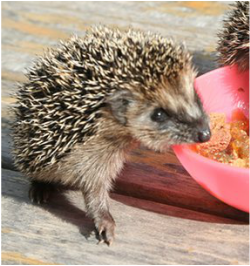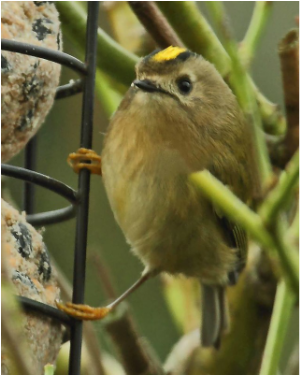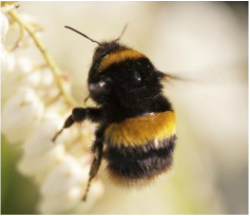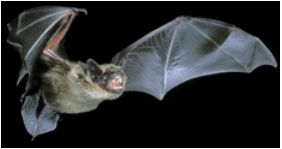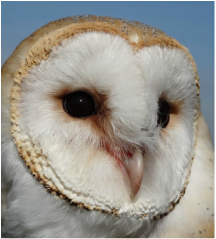Providing somewhere for the local wildlife to start a family.
Due to the amount of new building that is going on in the Parish of Woodbury a huge a huge amount of natural habitat has been lost. Animals are being squeezed out of their normal habitat and there ar far fewer foraging or nesting sites. Just providing a nest box isn't the answer. Animals consider numerous factors before they set up home. The most important factor is access to food and water. Without these resources being available at the right time the young may hatch or be born but they will not make it to maturity.
The second factor is security. The entrance to the nest box must be the right size. If the entrance to the nest is too large a more substantial creature will drive them out and steal the nest for themselves. Even worse when the young are born a predator will get in and take the young. Many bird boxes come with the option of fitting a selection of faces with holes suitable for specific species of birds. The entrances to bat boxes and the internal spaces have to be a particular size or they will not get used. Hedgehog homes have an opening of 140 x 140mm ( 14 centimetres ) so that badgers dogs and foxes cannot get into them.
Temperature & exposure is another important factor. For example Bat boxes are normally deployed in three’s around a tree. In cold weather the bats will roost in the box that is exposed to the warm sunshine, but hot conditions they will choose the box that is in the shade. Some species such as Barn Owls need the entrance to the nest to be unobstructed whereas others may prefer the shelter of a hedgerow so that they are not susceptible to attack from birds of prey.
Due to the amount of new building that is going on in the Parish of Woodbury a huge a huge amount of natural habitat has been lost. Animals are being squeezed out of their normal habitat and there ar far fewer foraging or nesting sites. Just providing a nest box isn't the answer. Animals consider numerous factors before they set up home. The most important factor is access to food and water. Without these resources being available at the right time the young may hatch or be born but they will not make it to maturity.
The second factor is security. The entrance to the nest box must be the right size. If the entrance to the nest is too large a more substantial creature will drive them out and steal the nest for themselves. Even worse when the young are born a predator will get in and take the young. Many bird boxes come with the option of fitting a selection of faces with holes suitable for specific species of birds. The entrances to bat boxes and the internal spaces have to be a particular size or they will not get used. Hedgehog homes have an opening of 140 x 140mm ( 14 centimetres ) so that badgers dogs and foxes cannot get into them.
Temperature & exposure is another important factor. For example Bat boxes are normally deployed in three’s around a tree. In cold weather the bats will roost in the box that is exposed to the warm sunshine, but hot conditions they will choose the box that is in the shade. Some species such as Barn Owls need the entrance to the nest to be unobstructed whereas others may prefer the shelter of a hedgerow so that they are not susceptible to attack from birds of prey.
We are concentrating on just five animals or groups of animals:
These are all under threat but can respond well given the right enviroment and help.
These are all under threat but can respond well given the right enviroment and help.
|
|
Hedgehogs
When hedgehogs will have finished their hibernation they will be looking for somewhere safe to build a nest. As they forage over a large area the female will be looking to build her nest where she can roam around looking for food with ease. If you want a hedgehog to set up home in your garden you will need to make sure that she has access to the surrounding gardens so that she is happy with the size of her territory. Form a couple of hedgehog holes in the fences on either side of your garden and you triple the size of her territory. Persuade your neighbours to put holes in their fences and you have the start of a hedgehog highway! Mark the location of the openings so that they don’t get blocked up and log any sightings on the Hedgehog society website. The ITV program Hedgehog Hotel provides a wonderful insight into the lives of these delightful little creatures - watch out for it to be repeated! Garden birds - most species are in decline due to a combination of factors. Changes in building practices have meant that they cannot nest in our homes. Changes in farming practices mean there are less hedgerows for them to nest in. The widespread use of pesticides means that there are less insects for them to eat. Installing nest boxes in the correct locations will help increase numbers. It is essential that we grow the correct plants and flowers in our gardens to attract insects and provide berries and seeds for them to eat. Nest boxes are available from most garden centres, supermarkets and hardware shops. They should be fixed with the entrance facing in a direction somewhere between North and East so that they don’t get too hot on sunny days and are sheltered from the cold wind and rain that normally comes from the south west. They should be sited away from your bird feeders so that they get less competition from the other birds in your garden. Thin walled or metal nest boxes should be avoided. The birds may nest in them but due to the lack of insulation property's they will get very hot in the summer and the chicks will die. Existing nesting boxes should be emptied and cleaned out each year and old nests removed before the birds start to use them. This is because parasites and diseases can build up in the old material. Bird feeders should also be cleaned well on a regular basis for the same reason. Nest boxes should be sited in different positions around your home and garden. Some birds like to nest in hedgerows while others like to nest in trees. Some birds like to use a nest box that is fixed to the trunk of a tree (such as a woodpecker) whereas some prefer a box that is fixed to a wall or shed (such as Bluetits). Robins will sometimes even nest in an old saucepan teapot or a wellington boot! House sparrows like to nest communally and special triple nest boxes fixed to the wall will be ideal for them. You can increase the chances of getting birds to nest around your property by providing a number of boxes in different shapes and sizes in different locations. By planting bird and bug friendly friendly plants in your garden and having a few bug hotels you will provide food for the chicks and give them a better chance of survival Bees and Bugs Widespread use of pesticides and weedkillers have had a severe impact on the many insects that we need to pollinate plants and feed our birds amphibians and mammals. Insects are essential for the production of most fruit and flowers. To a large extent most small carnivores depend on insects and their larvae for food. Without a good supply of insects the chicks of birds that nest around your home will not survive. Hedgehogs will not be attracted to your garden foraging for bugs ( and slugs ). Your pond will not attract newts or frogs, and the balance of nature in your garden will be wrong. Bug Hotels are a great way to provide somewhere for bees and bugs to nest. They can be purchased from garden centers but most people make their own. The simplest bug hotels are made by cutting a few hollow canes into short lengths them making them into a bundle using string or Duct Tape. Another form of bug hotel is a simple wooden frame that is infilled with lengths of cane, twigs, straw, fircones, terracotta slate etc. This type of bug hotel provides a decorative feature as well as a wildlife refuge. Some of the more imaginative design's are true works of art in their own right and people spend large sums of money on them. Drilling a number of small hole's of various sizes in a piece of wood is a variation on the theme and can be very effective. If enough space is available super hotels can be constructed using wooden pallets. These structures not only provide somewhere for insects to thrive. Small mammals can utilise the space at the bottom to provide shelter or a nest site with great food supply on tap. Many insects have evolved over millions of years to live with specific plants. This is why we need to plant native species of plants, trees and bushes in our gardens and open spaces. The traditional Oak tree will on average support about 350 different species whereas the none native Rhododendron supports none. Wildflower seed mixes are available from all garden centres and can easily be grown in all sorts containers baskets and window boxes so you don't even need to have a garden. Bats In Devon we have sixteen of the eighteen different species of bats that are normally found in the UK. Most of the species are in decline due to the loss of habitat and the use of pesticides. Bats are protected by law and no one is allowed to move or disturb them unless they have a special license. The presence of bats around your property is a great advantage as they eat approximately 30,000 Midge's every night. As part of an alliance with the Devon Bat Group we hope to identify five sites where it would be beneficial to install bat boxes. The boxes are specifically designed to provide an artificial roosting site for the bats and are normally grouped in three's around a suitable tree. We plan to build 9 additional boxes during 2019 and will carefully monitor them to see if they are being effective. If you already have bats roosting on your property please let us know info@wild-woodbury.org and we will add the location to our records. Owls We have quite a few Owls in the parish. Our Owl survey in the Summer of 2016 showed that we have Tawny Owls, Barn Owls and Little Owls in the parish and we are taking any action we can take to help the to thrive. We aim to find suitable locations for even more Owl boxes - If you can suggest any please email us |
